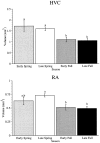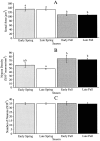Seasonal changes in testosterone, neural attributes of song control nuclei, and song structure in wild songbirds
- PMID: 9221796
- PMCID: PMC6573192
- DOI: 10.1523/JNEUROSCI.17-15-06001.1997
Seasonal changes in testosterone, neural attributes of song control nuclei, and song structure in wild songbirds
Abstract
Seasonal changes in the neural attributes of brain nuclei that control song in songbirds are among the most pronounced examples of naturally occurring plasticity in the adult brain of any vertebrate. The behavioral correlates of this seasonal neural plasticity have not been well characterized, particularly in songbird species that lack adult song learning. To address this question, we investigated the relationship between seasonal changes in gonadal steroids, song nuclei, and song behavior in adult male song sparrows (Melospiza melodia). At four times of the year, we measured plasma concentrations of testosterone, neural attributes of song nuclei, and several aspects of song structure in wild song sparrows of a nonmigratory population. We found seasonal changes in the song nuclei that were temporally correlated with changes in testosterone concentrations and with changes in song stereotypy. Male song sparrows sang songs that were more variable in structure in the fall, when testosterone concentrations were low and song nuclei were small, than in the spring, when testosterone concentrations were higher and song nuclei were larger. Despite seasonal changes in the song nuclei, the song sparrows continued to sing the same number of different song types, indicating that changes in the song nuclei were not correlated with changes in song repertoire size. These results suggest that song stereotypy, but not repertoire size, is a potential behavioral correlate of seasonal plasticity in the avian song control system.
Figures





Similar articles
-
Breeding conditions induce rapid and sequential growth in adult avian song control circuits: a model of seasonal plasticity in the brain.J Neurosci. 2000 Jan 15;20(2):854-61. doi: 10.1523/JNEUROSCI.20-02-00854.2000. J Neurosci. 2000. PMID: 10632615 Free PMC article.
-
[Meaning and Mechanisms of Birdsong: Inspiration for Pneumology].Pneumologie. 2025 Jun;79(6):427-438. doi: 10.1055/a-2463-7380. Epub 2025 Jan 31. Pneumologie. 2025. PMID: 39889729 Review. German.
-
Seasonal plasticity of the song control system in wild Nuttall's white-crowned sparrows.J Neurobiol. 1998 Jan;34(1):69-82. doi: 10.1002/(sici)1097-4695(199801)34:1<69::aid-neu6>3.0.co;2-a. J Neurobiol. 1998. PMID: 9469619
-
Seasonal changes in intrinsic electrophysiological activity of song control neurons in wild song sparrows.J Comp Physiol A Neuroethol Sens Neural Behav Physiol. 2007 Jun;193(6):677-83. doi: 10.1007/s00359-007-0222-1. Epub 2007 Apr 14. J Comp Physiol A Neuroethol Sens Neural Behav Physiol. 2007. PMID: 17440735
-
Behavioral interventions to reduce risk for sexual transmission of HIV among men who have sex with men.Cochrane Database Syst Rev. 2008 Jul 16;(3):CD001230. doi: 10.1002/14651858.CD001230.pub2. Cochrane Database Syst Rev. 2008. PMID: 18646068
Cited by
-
Testosterone modulation of angiogenesis and neurogenesis in the adult songbird brain.Neuroscience. 2013 Jun 3;239:139-48. doi: 10.1016/j.neuroscience.2012.12.043. Epub 2013 Jan 3. Neuroscience. 2013. PMID: 23291451 Free PMC article. Review.
-
Influence of testosterone metabolites on song-control system neuroplasticity during photostimulation in adult European starlings (Sturnus vulgaris).PLoS One. 2012;7(7):e40060. doi: 10.1371/journal.pone.0040060. Epub 2012 Jul 6. PLoS One. 2012. PMID: 22792214 Free PMC article.
-
Toward an integrative understanding of social behavior: new models and new opportunities.Front Behav Neurosci. 2010 Jun 28;4:34. doi: 10.3389/fnbeh.2010.00034. eCollection 2010. Front Behav Neurosci. 2010. PMID: 20661457 Free PMC article.
-
Seasonal changes in the song control nuclei of the Rufous-bellied Thrush, Turdus rufiventris (Oscine, Passeriformes, and Turdidae).J Exp Zool B Mol Dev Evol. 2019 May;332(3-4):92-98. doi: 10.1002/jez.b.22853. Epub 2019 Apr 19. J Exp Zool B Mol Dev Evol. 2019. PMID: 31004403 Free PMC article.
-
Transsynaptic trophic effects of steroid hormones in an avian model of adult brain plasticity.Front Neuroendocrinol. 2015 Apr;37:119-28. doi: 10.1016/j.yfrne.2014.09.003. Epub 2014 Oct 5. Front Neuroendocrinol. 2015. PMID: 25285401 Free PMC article. Review.
References
-
- Alvarez-Buylla A, Kirn J, Nottebohm F. Birth of projection neurons in adult avian brain may be related to perceptual or motor learning. Science. 1990;249:1444–1446. - PubMed
-
- Arai O, Taniguchi I, Saito N. Correlation between the size of song control nuclei and plumage color change in orange bishop birds. Neurosci Lett. 1989;98:144–148. - PubMed
-
- Arnold AP. The effects of castration and androgen replacement on song, courtship, and aggression in zebra finches (Poephila guttata). J Exp Zool. 1975;191:309–326. - PubMed
-
- Arnold AP. Effects of androgens on volumes of sexually dimorphic brain regions in the zebra finch. Brain Res. 1980;185:441–444. - PubMed
-
- Baker MC, Bottjer SW, Arnold AP. Sexual dimorphism and lack of a seasonal change in vocal control regions of the white-crowned sparrow brain. Brain Res. 1984;295:85–89. - PubMed
Publication types
MeSH terms
Substances
Grants and funding
LinkOut - more resources
Full Text Sources
